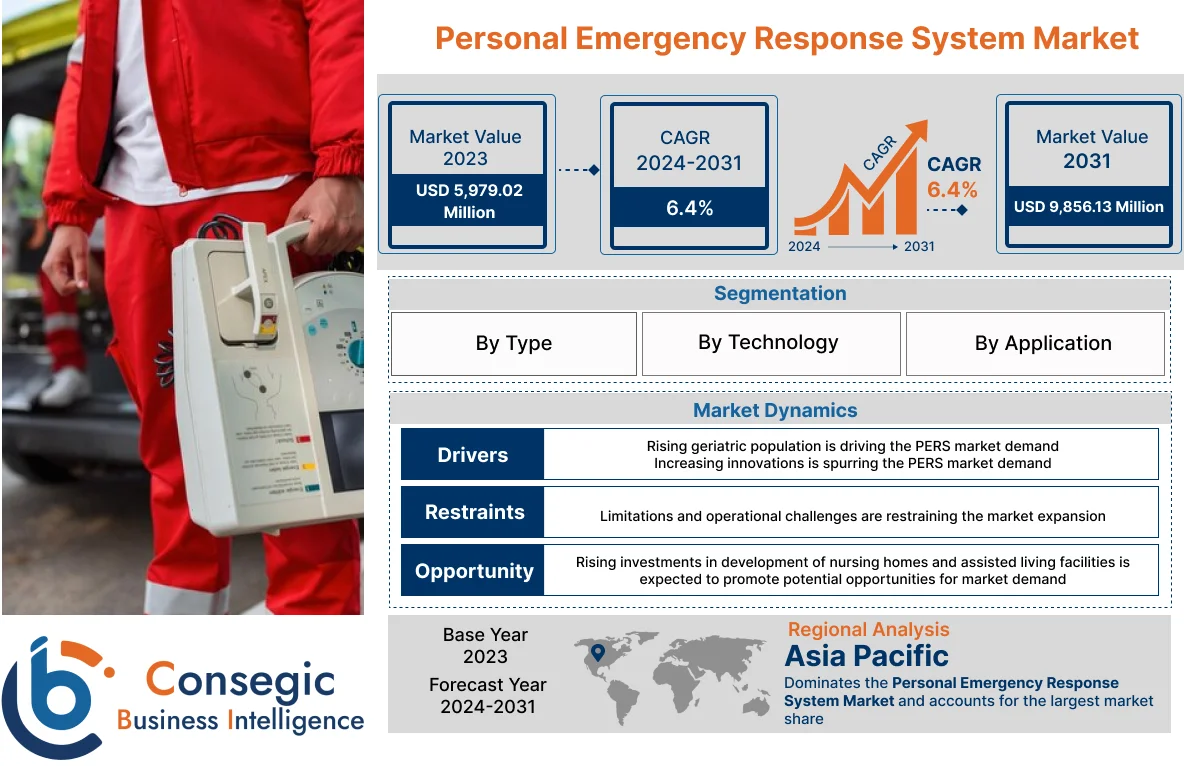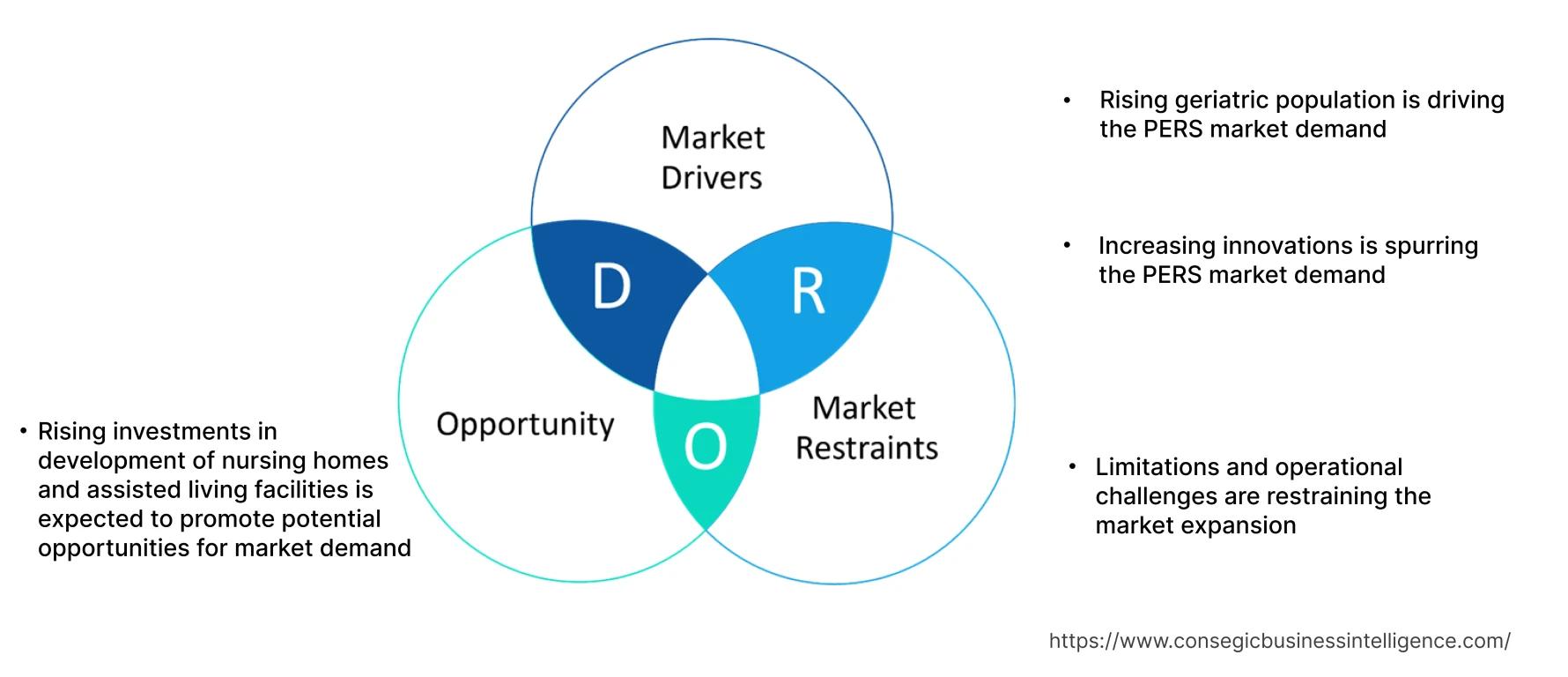Personal Emergency Response System Market Size :
Personal Emergency Response System Market size is estimated to reach over USD 9,856.13 Million by 2031 from a value of USD 5,979.02 Million in 2023 growing at a CAGR of 6.4% from 2024 to 2031.
Personal Emergency Response System Market Scope & Overview :
Personal emergency response systems (PERS), also known as medical alert systems, refers to devices that connect users with emergency response center in case of medical emergencies. Moreover, as per the analysis, these systems offer a range of benefits including immediate assistance, ease of use, 24/7 monitoring, enhanced mobility, and others. The aforementioned benefits of these response systems are major determinants for increasing its deployment in home healthcare, assisted living facilities, nursing home and other related applications.
How is AI Transforming the Personal Emergency Response System Market?
The integration of AI is significantly transforming the personal emergency response system market, specifically by facilitating real-time, predictive, and personalized monitoring of health conditions, which contributes to faster and more accurate emergency detection. Moreover, AI integration enhances safety through advanced algorithms for analyzing data, automated response protocols, fall detection, voice recognition, and personalized alerts that are tailored to individual user profiles and behavior patterns. Further, AI integration leads to faster, more accurate emergency responses, improved user safety, and supports remote patient monitoring and device management. Therefore, the aforementioned factors are expected to drive the market growth in upcoming years.
Personal Emergency Response System Market Insights :
Key Drivers :
Rising geriatric population is driving the PERS market demand
Geriatric population refers to elderly individuals aged 65 years and over. Elderly population are more prone to suffering from chronic health conditions, disabilities, and medical emergencies that require constant monitoring to ensure their safety. Emergency response systems are primarily used for providing constant monitoring of elderly individual's health condition and ensuring immediate medical attention in case of emergencies. Thus, as per the analysis, the rising prevalence of geriatric population is a prime factor driving the adoption of these emergency response systems.
For instance, according to the United States Census Bureau, the total number of elderly population in the U.S. with age 65 years and above reached 56,193 thousand in 2022, accounting for 17.1% of the total U.S. population. Additionally, according to Eurostat, over 21.1% of the population in the European Union was aged 65 and over in 2022.
Therefore, the rising geriatric population is driving the adoption of these emergency response systems to provide constant monitoring of elderly individual's health condition and ensure immediate medical attention in case of emergencies. The above factors are proliferating the personal emergency response system market trends and demand.
Increasing innovations is spurring the PERS market demand
Personal emergency response system providers are constantly investing in the development of new technologies integrated with new features to ensure its efficient utilization in multiple applications including home healthcare, nursing homes, and others. Hence, these companies are launching new products with updated features and advancements.
For instance, in September 2020, HandsFree Health launched its new voice-enabled medical alert system. Based on the analysis, the medical alert system integrates 24/7 emergency monitoring with voice assistance for improved wellness support and emergency services.
Additionally, in November 2023, TELUS Health introduced its next-generation of medical alert system that includes a discrete wearable device optimized for empowering older adults and providing 24/7 emergency support. The wearable device is integrated with a connected Caregiver App that that enables care givers to receive updates about the user's daily routines, location, and mobility when required. Therefore, the increasing innovations accelerate the personal emergency response system market growth and trends.
Key Restraints :
Limitations and operational challenges are restraining the market expansion
The utilization of these emergency response systems is usually associated with few limitations and operational challenges, which is a key factor limiting the market trends.
For instance, many emergency response systems utilize phone lines to contact emergency services in case an alarm is triggered. As a result, disconnected phone lines may hamper the system's performance to alert emergency services in critical situations. Moreover, as per the analysis, these response systems are often susceptible to system malfunctions, false alarms, and dead battery due to limited battery life, in turn hampering its functionalities.
Additionally, these emergency response systems integrated with fall detection technology may face issues with user compliance as fall detection capability works effectively only when individuals use it correctly. Therefore, the aforementioned limitations and operational challenges are associated with restraining the personal emergency response system market trends.
Future Opportunities :
Rising investments in development of nursing homes and assisted living facilities is expected to promote potential opportunities for market demand
The rising investments in development of nursing homes and assisted living facilities is expected to present potential personal emergency response system market opportunities and trends in the coming years. Nursing homes and assisted living facilities specializes in residential care of elderly people, senior citizens, and disabled individuals. These emergency response systems are often used in nursing homes and assisted living facilities to connect senior citizens, elderly people suffering from chronic health conditions, and disabled individuals residing in such facilities with emergency response center in case of medical emergencies.
As per the analysis, factors including the rising investments in development of nursing homes, increasing prevalence of chronic diseases, and growing elderly population are expected to promote lucrative trends aspects for the market.
For instance, in December 2020, Antara Assisted Care Services Limited launched a new 37-bed nursing home facility for elderly individuals in South Delhi, India. The facility is developed for senior citizens aged over 55 years, who require immersive interventions and care in their daily lives due to age-related or medical issues. Antara Assisted Care Services further announced its plan to invest over USD 35 million in the next four years to develop more senior care facilities and services across the country. Hence, the rising investments in the development of nursing homes and assisted living facilities is projected to drive the adoption of these emergency response systems to provide constant monitoring of elderly individual's health conditions and ensure immediate medical attention in case of emergencies, in turn promoting opportunities and potential personal emergency response system market trends during the forecast period.
Personal Emergency Response System Market Report Insights :
| Report Attributes | Report Details |
| Study Timeline | 2018-2031 |
| Market Size in 2031 | USD 9,856.13 Million |
| CAGR (2024-2031) | 6.4 % |
| By Type | Landline Personal Emergency Response System, Cellular Personal Emergency Response System, Mobile Personal Emergency Response System, GPS-Based Personal Emergency Response System, App-Based Personal Emergency Response System, and Others |
| By Technology | Bluetooth, GPS, Fall Detection Technology, and Others |
| By Application | Home Healthcare, Assisted Living Facilities, Nursing Homes, and Others |
| By Region | Asia-Pacific, Europe, North America, Latin America, Middle East & Africa |
| Key Players | ADT, Bay Alarm Medical, Alpine Communications, Lifeline, ModivCare, Tunstall Healthcare, Medical Guardian LLC, AlertOne Services LLC, Rescue Alert, Bridgera |
| Geographies Covered | |
| North America | U.S. Canada Mexico |
| Europe | U.K. Germany France Spain Italy Russia Benelux Rest of Europe |
| APAC | China South Korea Japan India Australia ASEAN Rest of Asia-Pacific |
| Middle East and Africa | GCC Turkey South Africa Rest of MEA |
| LATAM | Brazil Argentina Chile Rest of LATAM |
| Report Coverage | Revenue Forecast, Competitive Landscape, Growth Factors, Restraint or Challenges, Opportunities, Environment & Regulatory Landscape, PESTLE Analysis, PORTER Analysis, Key Technology Landscape, Value Chain Analysis, Cost Analysis, and Regional Trends & Forecast |
Personal Emergency Response System Market Segmental Analysis :
By Type :
Based on the type, the market is bifurcated into landline personal emergency response system, cellular personal emergency response system, mobile personal emergency response system, GPS-based personal emergency response system, app-based personal emergency response system, and others. The mobile personal emergency response system segment accounted for a highest revenue share in the year 2023. Mobile personal emergency response systems are designed to work anywhere, similar to a mobile phone. Mobile personal emergency response systems utilize cellular networks for connecting to an emergency response center and are often integrated with GPS to help locate users in case of an emergency. Moreover, mobile personal emergency response systems offer a range of benefits including increased portability, higher flexibility, two-way communication support, location-based features, and others.
For instance, in January 2022, Essence launched its new 5G-enabled mobile personal emergency response system. The device is integrated with real-time activity monitoring, built-in fall detection, and two-way voice capabilities. Thus, rising innovation associated with mobile personal emergency response system is among the prime factors driving the personal emergency response system market demand.
The GPS-based personal emergency response system segment is anticipated to register the fastest CAGR during the forecast period. GPS-based personal emergency response system employs global positioning system technology for identifying the user's location during an emergency situation. GPS-based personal emergency response system is particularly useful for individuals who experience an emergency outside of the home or individuals who spend a lot of time outdoors.
For instance, HomeCentris Healthcare LLC launched a personal emergency response system integrated with GPS tracking capabilities in its product portfolio to track individual's location in case of emergencies. Therefore, rising advancements associated with GPS-based personal emergency response system are anticipated to boost the trends of the market during the forecast period.
By Technology :
Based on the technology, the market is bifurcated into Bluetooth, GPS, fall detection technology, and others. The Bluetooth segment accounted for the largest personal emergency response system market share of 39.17% in the year 2023. Bluetooth employs a short range wireless communication technology for exchanging data by utilizing short-wavelength UHF radio waves. Bluetooth technology enables these response system users to control the device in a wireless manner while simplifying data sharing and reducing time consumption during emergency situations. Moreover, the integration of Bluetooth technology in these response systems offers several features including movement sensing, vitals monitoring, fitness tracking, medication reminders, and other related features.
For instance, Talius Group Ltd. offers personal emergency response system integrated with Bluetooth technology in its product portfolio to provide improved care solutions to aged and disabled individuals. Therefore, the rising integration of Bluetooth technology in these response systems is a prime factor proliferating the expansion of the segment.
The GPS segment is anticipated to register fastest CAGR during the forecast period. GPS technology is often integrated in personal safety and security devices to enable individual's location tracking for improved monitoring along with retrieval of precise locations for sending aid in case of medical emergencies.
For instance, ADT offers on-the-go series of these response system integrated with GPS technology for providing individual location in real-time. Thus, the increasing integration of GPS technology in these response systems for precise location monitoring and tracking is a key factor projected to drive the expansion of the segment during the forecast period.
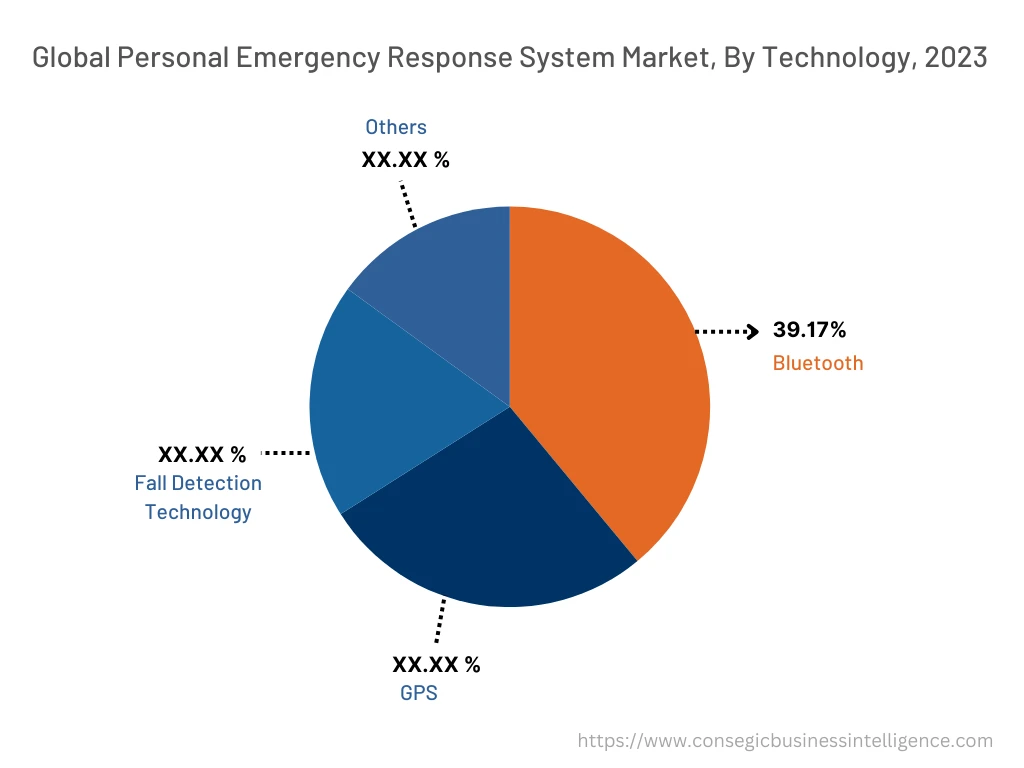
By Application :
Based on the application, the market is segregated into home healthcare, assisted living facilities, nursing homes, and others. The home healthcare segment accounted for the largest revenue share in the year 2023. Factors including the increasing prevalence of prolonged diseases, growing geriatric population, and rising implementation of self-health management are vital prospects driving the expansion of the home healthcare segment.
For instance, according to Australian Institute of Health and Welfare, there were an estimated 4.2 million elderly population aged 65 and over in Australia as of 2020, geriatric population accounting for 16% of the total Australian population. Therefore, the growing prevalence of geriatric population is driving the adoption of these response system to facilitate home healthcare services to individuals and generate alerts in case of medical emergencies, in turn driving the expansion of the market.
Nursing homes segment is expected to witness fastest CAGR during the forecast period. The growth of nursing homes segment is primarily driven by multiple factors including rising investments in development of nursing homes, increasing prevalence of chronic diseases, and growing elderly population among others.
For instance, there are approximately 18,064 nursing homes in India as of September 2023. These response systems are often used in nursing homes to connect senior citizens, elderly people suffering from chronic health conditions, and disabled individuals residing in the facility with emergency response center in case of medical emergencies. Thus, the rising development of nursing homes is a key factor anticipated to drive the market growth during the forecast period.
By Region :
The regional segment includes North America, Europe, Asia Pacific, Middle East and Africa, and Latin America.
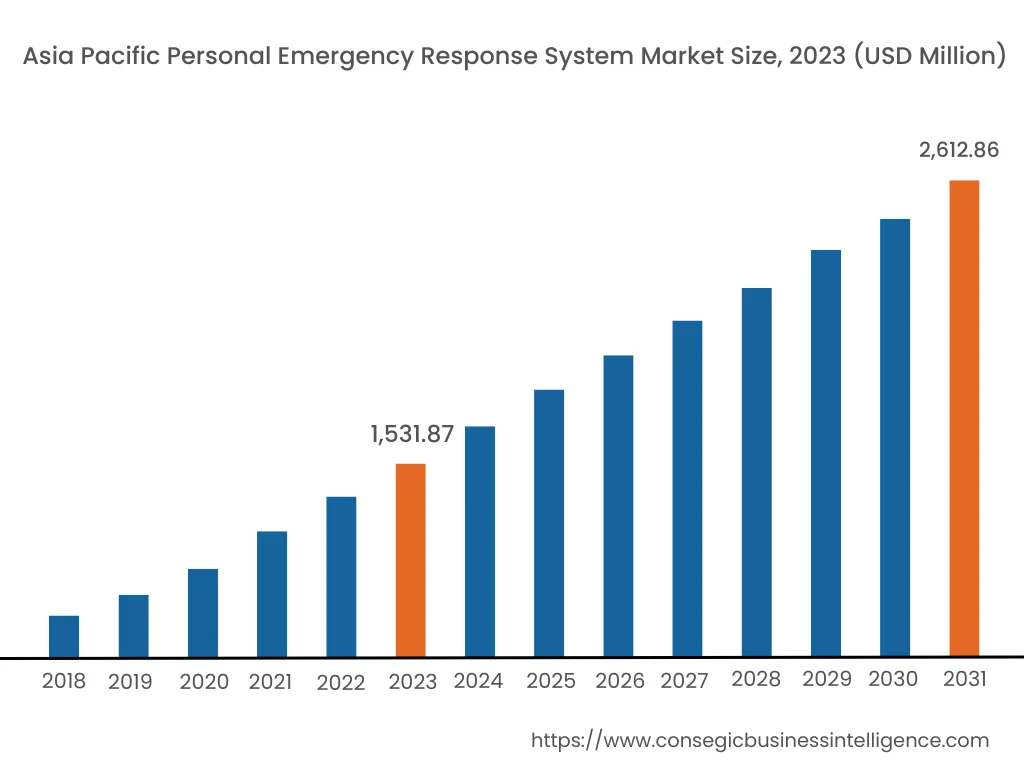
Asia-Pacific accounted for the largest revenue share of USD 1,531.87 Million in 2023 and is expected to reach USD 2,612.86 Million by 2031, registering the highest CAGR of 6.9% during the forecast period. In addition, in the region, the China accounted for the maximum potential personal emergency response system market share of 31.4% in the same year.
Based on the personal emergency response system market analysis, factors including rising geriatric population with chronic conditions and prevalence of significant number of nursing homes are driving the market demand for these response system in the Asia-Pacific region.
For instance, according to United Nations Population Fund (UNFPA), there were approximately 149 million individual aged 60 years and above in India in 2022, accounting for 10% of the country's total population. UNFPA further states that the elderly population in India is projected to reach 347 million by 2050. Thus, the rising geriatric population is driving the adoption of these response systems to provide constant monitoring of elderly individual's health conditions and ensure immediate medical attention in case of emergencies, thereby, boosting market growth in the region during the forecast period.
For instance, in January 2023, Genesis Healthcare Inc. announced the addition of 34 nursing homes in Pennsylvania, United States, as a part of its expansion strategy to deliver improved patient care. The above factors are driving the adoption of these response systems for connecting senior citizens, elderly people suffering from chronic health conditions, and disabled individuals residing in nursing homes with emergency response center in case of medical emergencies, in turn driving the market growth in North America.
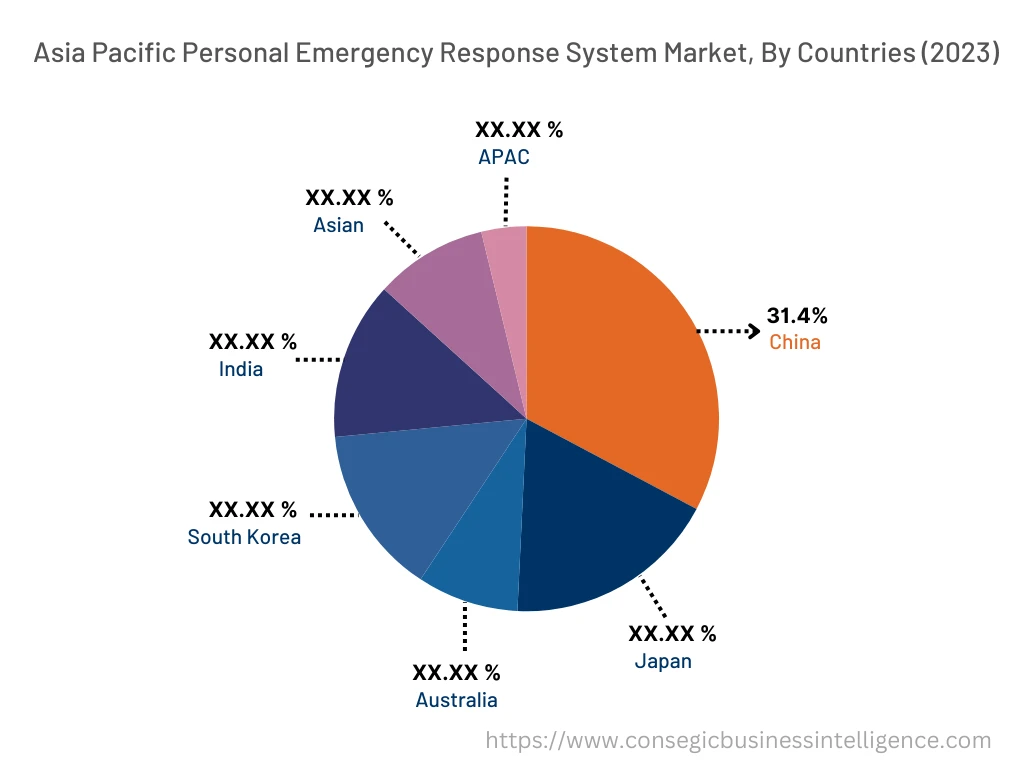
Top Key Players & Market Share Insights :
The global personal emergency response system market is highly competitive with major players providing these systems to the national and international markets. Key players are adopting several strategies in research and development (R&D), product innovation, and application launches to hold a strong position in the market. Key players in the personal emergency response system industry include-
- ADT
- Bay Alarm Medical
- Lifeline
- ModivCare
- Tunstall Healthcare
- Alpine Communications
- Medical Guardian LLC
- AlertOne Services LLC
- Rescue Alert
- Bridgera
Recent Industry Developments :
- In January 2023, FallCall Solutions partnered with HSC Technology Group to launch Android and iPhone-based personal emergency response system in Australia. The system can connect several 24/7 response partners throughout Australia to users on their mobile phones for assessing the situation and send aid if required.
Key Questions Answered in the Report
What is personal emergency response system? +
Personal emergency response systems (PERS), also known as medical alert systems, refers to devices that connects users with emergency response center in case of medical emergencies.
What specific segmentation details are covered in the personal emergency response system report, and how is the dominating segment impacting the market growth? +
For instance, by type segment has witnessed mobile personal emergency response system as the dominating segment in the year 2023, owing to the increasing adoption of mobile personal emergency response system due to its several benefits including higher flexibility, increased portability, two-way communication support, and others.
What specific segmentation details are covered in the personal emergency response system market report, and how is the fastest segment anticipated to impact the market growth? +
For instance, by application segment has witnessed nursing homes as the fastest-growing segment during the forecast period due to rising adoption of personal emergency response systems in nursing home for constant monitoring and safety of elderly citizens and disabled/ill individuals within the facility, specifically in cases of emergencies.
Which region/country is anticipated to witness the highest CAGR during the forecast period, 2024-2031? +
Asia-Pacific is anticipated to register fastest CAGR growth during the forecast period due to rising geriatric population with chronic conditions, prevalence of significant number of nursing homes, and other related factors.
